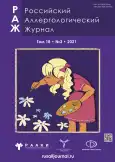Pediatric anaphylaxis: unresolved issues of diagnosis and patient management
- Authors: Pampura A.N.1, Esakova N.V.1
-
Affiliations:
- Veltischev Research and Clinical Institute for Pediatrics of the Pirogov Russian National Research Medical University
- Issue: Vol 18, No 3 (2021)
- Pages: 131-136
- Section: Letters to the editor
- URL: https://journals.rcsi.science/raj/article/view/121731
- DOI: https://doi.org/10.36691/RJA1482
- ID: 121731
Cite item
Full Text
Abstract
The incidence of anaphylaxis is increasing in children. Children suffering from anaphylaxis represent a complex and ambiguous group of patients. The factors that cause difficulties in diagnosing anaphylaxis in children are as follows: a wide range of triggers, unpredictability of the nature, severity of clinical symptoms of systemic reactions, and their age-dependent interpretation. The first anaphylactic reaction always stuns parents and medical staff, which leads to a subjective description of the anamnesis and a delay in making a diagnosis and prescribing the correct treatment. For these patients, problems such as the lack of available diagnostic tests for verifying the diagnosis of anaphylaxis, restriction of standard doses of epinephrine autoinjectors, lack of predictors of the occurrence, and severity of systemic allergic reactions continue to be relevant.
The article focused on the most urgent difficulties and features of managing patients with anaphylaxis in pediatric practice and discussed possible prospects and ways to solve them.
Keywords
Full Text
##article.viewOnOriginalSite##About the authors
Alexander N. Pampura
Veltischev Research and Clinical Institute for Pediatrics of the Pirogov Russian National Research Medical University
Email: apampura@pedklin.ru
ORCID iD: 0000-0001-5039-8473
SPIN-code: 9722-7961
MD, Dr. Sci. (Med.)
Russian Federation, 2, Taldomskaya street, Moscow, 125412Natalia V. Esakova
Veltischev Research and Clinical Institute for Pediatrics of the Pirogov Russian National Research Medical University
Author for correspondence.
Email: env007@rambler.ru
ORCID iD: 0000-0001-8792-2670
SPIN-code: 6924-9726
MD, Cand. Sci. (Med.)
Russian Federation, 2, Taldomskaya street, Moscow, 125412References
- Lin RY, Anderson AS, Shah SN, Nurruzzaman F. Increasing anaphylaxis hospitalizations in the first 2 decades of life: New York State, 1990–2006. Ann Allergy Asthma Immunol. 2008;101(4):387–393. doi: 10.1016/S1081-1206(10)60315-8
- Poulos LM, Waters AM, Correll PK, et al. Trends in hospitalizations for anaphylaxis, angioedema, and urticaria in Australia, 1993–1994 to 2004–2005. J Allergy Clin Immunol. 2007;120(4):878–884. doi: 10.1016/j.jaci.2007.07.040
- Wang Y, Allen KJ, Suaini NH, et al. The global incidence and prevalence of anaphylaxis in children in the general population: a systematic review. Allergy. 2019;74(6):1063–1080. doi: 10.1111/all.13732
- Esakova N, Treneva M, Okuneva T, Pampura AN. Food anaphylaxis: reported cases in Russian federation children. Am J Public Health Research. 2015;3(5):187–191. doi: 10.12691/ajphr-3-5-2
- Lepeshkova TS. Analysis of the prevalence of food hypersensitivity and food anaphylaxis in the children’s population of Yekaterinburg. Russian Allergological Journal. 2021;18(2):46–54. (In Russ). doi: 10.36691/RJA1427
- Lee S, Hess EP, Lohse C, et al. Trends, characteristics, and incidence of anaphylaxis in 2001–2010: A population-based study. J Allergy Clin Immunol. 2017;139(1):182–188.e2. doi: 10.1016/j.jaci.2016.04.029
- Huang F, Chawla K, Jarvinen KM, Nowak-Węgrzyn A. Anaphylaxis in a New York City pediatric emergency department: triggers, treatments, and outcomes. J Allergy Clin Immunol. 2012;129(1):162–168. doi: 10.1016/j.jaci.2011.09.018
- Pampura AN, Esakova NV. Anaphylaxis in children. Moscow: ID MEDPRAKTIKA-M; 2020. 368 р. (In Russ).
- Cardona V, Ansotegui IJ, Ebisawa M, et al. World allergy organization anaphylaxis guidance, 2020. World Allergy Organ J. 2020;13(10):100472. doi: 10.1016/j.waojou.2020.100472
- Sampson HA, Munoz-Furlong A, Campbell RL, et al. Second symposium on the definition and management of anaphylaxis: summary report ― Second National Institute of Allergy and Infectious Disease/Food Allergy and Anaphylaxis Network symposium. J Allergy Clin Immunol. 2005;117(2):391–397. doi: 10.1016/j.jaci.2005.12.1303
- Astafyeva NG, Bayalieva AZ, Zabolotskikh IB, et al. Anaphylactic shock. Clinical recommendations. Russian Allergological Journal. 2021;18(1):56–72. (In Russ). doi: 10.36691/RJA1422
- Greenberger PA, Rotskoff BD, Lifschultz B. Fatal anaphylaxis: postmortem findings and associated comorbid diseases. Ann Allergy Asthma Immunol. 2007;98(3):252–257. doi: 10.1016/S1081-1206(10)60714-4
- Pumphrey R, Sturm G. Risk factors for fatal anaphylaxis. In: D.A. Moneret-Vautrin, ed. Advances in anaphylaxis management. London: Future Medicine; 2014. Р. 32–48. doi: 10.2217/fmeb2013.13.248
- Akin C, Soto D, Brittain E, et al. Tryptase haplotype in mastocytosis: relationship to disease variant and diagnostic utility of total tryptase levels. Clin Immunol. 2007;123(3):268–271. doi: 10.1016/j.clim.2007.02.007
- Heaps A, Carter S, Selwood C, et al. The utility of the ISAC allergen array in the investigation of idiopathic anaphylaxis. Clin Exp Immunol. 2014;177(2):483–490. doi: 10.1111/cei.12334.
- Sicherer SH, Simons FE; AAP Section on Allergy and Immunology. Epinephrine for first-aid management of anaphylaxis. Pediatrics. 2017;139(3):e20164006. doi: 10.1542/peds.2016-4006
Supplementary files






